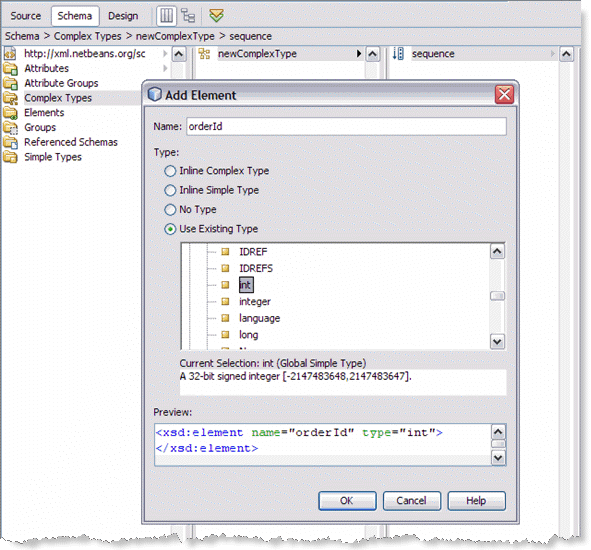Creating the XML Schemas
The next step in the Purchase Order sample project is to create the XML schemas
The HTTP-SOAP-PO-BPEL sample project includes two XML schema files. In this section, you create two new XML schema files for your BPEL Module project, inventory.xsd and purchaseOrder.xsd.
Creating the inventory.xsd Schema
The inventory.xsd XML schema enables the BPEL Service Engine to check the current inventory for a requested item.
 To create the inventory.xsd schema
To create the inventory.xsd schema
-
In the Projects window, right-click the HTTP-SOAP-PO-BPEL node and select New -> Other from the pop-up menu.
The New File Wizard appears.
-
In the Categories field, select XML, and in the File Types field, select XML Schema.
-
Click Next.

-
From the second page of the wizard, Name and Location, type inventory as the File Name.
-
Click Finish.
In the Projects window, the Process Files node now contains a subnode named inventory.xsd. The Source Editor contains a tab for the XML schema file, inventory.xsd, with the Schema view open.
 To add a complex type to the XML Schema
To add a complex type to the XML Schema
-
From the Schema view of the inventory.xsd, right-click the Complex Type node and select Add Complex Type from the pop-up menu.
-
From the Add Complex Type dialog box, click OK. A complex type (newComplexType) is added to the second pane of the Schema window and a sequence node is added to the third pane of the Schema window.
 Add Local Elements to the XML Schema
Add Local Elements to the XML Schema
-
From the Schema window, right-click the sequence node and select Add -> Element from the pop-up menu.
The Add Element dialog box appears.
-
From the Add Element dialog box, do the following:
-
From the Schema window, right-click the sequence node again, and select Add -> Element from the pop-up menu.
The Add Element dialog box appears.
-
From the Add Element dialog box, do the following:
-
From the Schema window, right-click the sequence node again, and select Add -> Element from the pop-up menu.
-
From the Add Element dialog box, do the following:
 To add a global element
To add a global element
-
From the left pane of the Schema window, right-click the Elements node, and select Add -> Element from the pop-up menu.
-
From the Add Element dialog box, do the following:
 To validate the XML Schema
To validate the XML Schema
-
From the Schema Editor toolbar, click the Validate XML button. Validation begins.
-
The Outlook window of the IDE displays the validation status. If any errors occur, double-click each error message to see the location of the error and make any necessary corrections. Run validation again to verify corrections.
-
If your validation is successful, click File -> Save All() to save your current changes.
Creating the purchaseOrder.xsd Schema
 To create the purchaseOrder.xsd schema
To create the purchaseOrder.xsd schema
-
In the Projects window, right-click the HTTP-SOAP-PO-BPEL -> Process Files node and select New -> XML Schema from the pop-up menu.
The XML Schema wizard appears displaying the Name and Location page.
-
From the Name and Location page of the wizard, enter purchaseOrder as the File Name.
-
Click Finish. In the Projects window, the Process Files node now contains a subnode labeled purchaseOrder.xsd . The Source Editor contains a tab for the XML schema file, purchaseOrder.xsd, with the Schema view open.
 To add a complex type to the XML schema
To add a complex type to the XML schema
-
From the Schema view of the purchaseOrder.xsd, right-click the Complex Type node and select Add Complex Type from the pop-up menu.
-
From the Add Complex Type dialog box, click OK. A complex type (newComplexType) is added to the second pane of the Schema window and a sequence node is added to the third pane of the Schema window.
 To add local elements to the XML schema
To add local elements to the XML schema
-
From the Schema window, right-click the sequence node and select Add -> Element from the pop-up menu.
The Add Element dialog box appears.
-
From the Add Element dialog box, do the following:
-
In the same manner, add three additional elements with the values shown in the following table:
Name
Type
Current Selection
Type
customerId
Use Existing Type
Built-in Type
int
orderDescription
Use Existing Type.
Built-in Type
String
price
Use Existing Type.
Built-in Type
double
 To add a global element
To add a global element
-
From the left pane of the Schema window, right-click the Elements node, and select Add -> Element from the pop-up menu.
-
From the Add Element dialog box, do the following:
 To validate the XML schema
To validate the XML schema
- © 2010, Oracle Corporation and/or its affiliates

